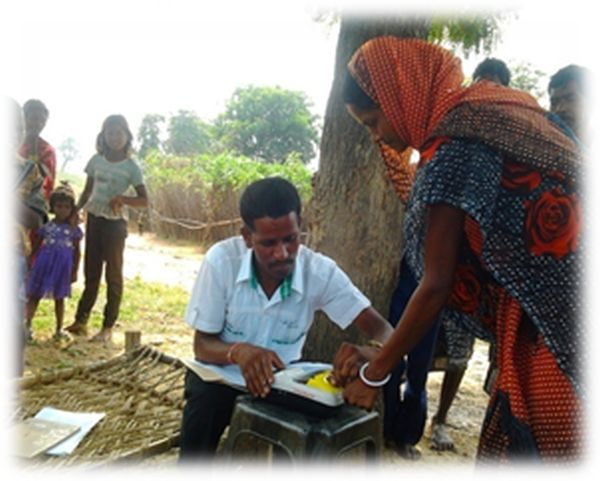PM Modi has emphasised fast-tracking roll-out of the Adhaar-based Direct Benefits Transfer programme. In this note, Sweta Trayambak – who has worked with the district administration of Ramgarh in Jharkhand on the roll-out of DBT - highlights the key strengths of the programme, and problems faced in implementation on the ground.
The United Progressive Alliance (UPA) government launched the Direct Benefit Transfer (DBT)/ Direct Cash Transfer (DCT) programme in January 2013. The programme involves transferring government benefits and subsidies directly into the hands of residents through a biometric-based identification system (Aadhaar1). It is expected to improve service delivery by speeding up payments, removing leakages, and enhancing financial inclusion. In the first phase of implementation, 26 centrally-sponsored schemes across 43 districts were linked to DBT/ DCT.
DBT covers schemes such as scholarships, Janani Suraksha Yojna (JSY)2, Indira Awaas Yojna (IAY)3 etc. that involve transferring cash to beneficiaries to incentivise consumption of a specific good like education, institutional deliveries, pucca housing and so on. DCT covers unemployment assistance, pensions, wages under the Mahatma Gandhi National Rural Employment Guarantee Act (MRNEGA) etc., wherein the purpose is to enhance levels of private consumption and achieve a minimum consumption level. Finally, subsidy transfers cover schemes wherein the government transfers a part of the total subsidy (example, on kerosene, fertiliser or Liquefied Petroleum Gas (LPG)) to beneficiaries, in lieu of subsidised physical good.
The basic procedure involves identification of beneficiaries under a particular scheme, enrolment by beneficiaries under Adhaar, opening of bank account by beneficiaries (with assistance from the district administration), linking of Adhaar with bank account by district administration, and transfer of payments to the bank accounts of beneficiaries. The DBT programme requires the bank account to be individually or jointly held by the beneficiary. To bring payments to the door step of beneficiaries, Adhaar-enabled micro-ATMs4 have been introduced.
The Ramgarh district of Jharkhand was one of the pilot districts for roll out of DBT/ DCT. In the first phase, the district administration focused on targeted scholarships, MNREGA wage payments and pension schemes. As a part of the Prime Minister’s Rural Development Fellowship (PMRDF)5 programme, I have been involved with the implementation of DBT/ DCT in the district. In this note, I highlight the key strengths of the programme and problems faced in implementation on the ground, and make suggestions for what the government should do to improve efficiency of DBT/ SCT.
What worked?
The district administration has expedited the process of opening bank accounts of beneficiaries and banks (both public and private) are taking special interest in the programme. The initiative has greatly helped check leakages/ wastage in welfare schemes, and reduced scope of fraud and corruption.
The beneficiaries are aware of whether or not they have received their wages, benefits or subsidies in their bank accounts. This is due to the requirement of the bank account being individually or jointly held by the beneficiary. Earlier, payments for a female beneficiary could be transferred to a bank account owned individually by her husband and hence, the woman may not always be aware of when the payment is received and the money may be misused by the husband. Also, ‘one beneficiary one Adhaar’ has helped check ghost workers under welfare programmes such as MNREGA.
Implementation hurdles
The following issues are faced by the different stakeholders involved in the programme on the ground:
- DBT/ DCT enrolment (obtaining Adhaar/ opening bank account/ linking bank account with Adhaar) is a hassle for beneficiaries that intend to use the programme only for getting one-time benefits, say under JSY or the incentive scheme for secondary education of girls. Enrolled beneficiaries have to wait for at least two months for getting Adhaar.
- The concept of DBT/ DCT is being diluted due to a lack of micro-ATMs to enable payment at the doorstep of beneficiaries. The beneficiaries need to visit the bank (usually outside the village) to obtain the payment. Even though Ramgarh district was identified as a pilot district for the programme, it has only three micro-ATMs till date.
- The micro-ATM that is available in Ramgarh for Adhaar-based payment at the moment sometimes reads finger prints of beneficiaries in five to seven attempts and beneficiaries have to return without payment due to this problem. This happens especially with MNREGA workers and pensioners.
- Most banks have appointed Business Correspondents (BC)6 for opening bank accounts at the Panchayat level. A major disadvantage is that BCs receive incentives for opening bank accounts so they open accounts for beneficiaries even if they already have one. The beneficiaries are not given pass books so they are not aware of the accounts opened by BCs. The district administration has received over 100 complaints regarding this issue.
- Beneficiaries are not aware that only one bank account is to be linked with DBT/ DCT. Payments are automatically transferred to the bank account of a beneficiary that has been linked to DBT/ DCT most recently. The district administration has not been provided with any system for determining how many bank accounts of one beneficiary have been linked for DBT/ DCT. This creates a lot of confusion on the ground.
- DBT/ DCT portals have not been developed and the district administration has to manage all the data in Excel files.
- A major issue is coordination among stakeholders involved in DBT/ DCT – district administration, banks, Unique Identification Authority of India (UIDAI) department, enrolment agencies and beneficiaries.
- District administration does not know how to address grievances related to the programme as they do not have the required trained task force. This is particularly true in the case of LPG subsidy.
Figure 1. Woman receiving MNREGA wages through biometric micro-ATM at work site

MNREGA wage payment through e-FMS
A form of DCT/ DBT that has been implemented is transfer of wage payments under MNREGA through Electronic Fund Management System (e-FMS). Under this system, wages are transferred from the bank to the head post office in the village; the Management Information System (MIS) gets updated when this transfer is made. Then, the beneficiary (who holds an account in the post office), withdraws money from the post office. Around 84% of MGNREGA workers in Ramgarh district have accounts in post offices.
While MIS gets updated immediately in real time, in reality, it takes more than 10 days for the money to go from the head post office to the workers. Hence, most MNREGA workers in the district do not want to receive wages through this system. Surprisingly, some post masters at the branch office level are unaware of the system.
There are several reasons for the delay:
- Post offices are not linked with the online system and money is transferred from the head post office to the sub-post offices manually/ by post. This increases scope for leakages.
- Post offices do not have any system to inform workers that their wages have arrived. They have to depend on friends or Rojgar Sevak7, which creates scope for leakage at the village level.
- Post masters have to visit sub-post offices to get the list of MNREGA workers, or they receive the list by post. They do not get the list as per Fund Transfer Order (FTO) (or Electronic Generated Advice) numbers and have to manually search for the names of workers and account numbers. They then themselves have to take the wage amount to the workers.
- Accounts at post offices in villages have poor infrastructure with no safety measures for keeping huge amounts of wage payments.
What should the government do?
- District administration should take initiative to enrol each beneficiary under Adhaar instead of giving deadlines to beneficiaries to submit their Adhaar application within a fixed time frame.
- Banks, UIDAI and the district administration should make beneficiaries, Panchayati Raj Institutions (PRI) and BCs aware that only one bank account is required to receive payments under all welfare schemes linked to DBT/ DCT.
- BC with biometric micro-ATM should make payment at door step of beneficiaries.
- Micro–ATMs should not be bank specific. Then beneficiaries will be able to open their account in any bank.
- The government should develop DBT/ DCT portal to make payments more transparent.
- A functional grievance redressal cell should be set up for catering to the problems faced by beneficiaries.
- E-FMS should be implemented through banks at the moment, as post offices are not ready for the programme. Sub-offices should be fully linked with the online system so as to avoid delays and prevent leakages. They should be provided with better infrastructure and trained personnel. All stakeholders need to be made aware regarding the e-FMS mechanism.
Notes:
- Aadhaar is a 12-digit individual identification number issued by the Unique Identification Authority of India (UIDAI) to residents on behalf of the Government of India, which serves as a proof of identity and residence through the country.
- Janani Suraksha Yojana (JSY) is a safe motherhood intervention under the National Rural Health Mission (NRHM). It is being implemented with the objective of reducing maternal and neonatal mortality by promoting institutional delivery among poor pregnant women.
- Indira Awaas Yojana (IAY), a flagship scheme of the Ministry of Rural Development, provides assistance in the form of full grant for construction of a safe and durable shelter for Below Poverty Line (BPL) families who are either houseless or have inadequate housing facilities.
- Micro-ATMs are handheld devices that are operated by Business Correspondents (BC) of banks. Transactions such as cash withdrawal, cash deposit, balance enquiry and remittance can be undertaken through Adhaar-enabled micro-ATMs.
- Prime Minister’s Rural Development Fellowship (PMRDF), a programme initiated by the Ministry of Rural Development, places qualified young men and women with district administrations in backward areas for a short time. The fellows assist in improving programme delivery and interface with the marginalised section of the population, aiming to reduce the developmental and governance deficit.
- Business Correspondent Model aims to encourage greater financial inclusion and increase the outreach of the banking sector by allowing Non-Governmental Organisations (NGOs)/ Self-Help Groups (SHGs)/ Micro Finance Institutions (MFIs) or Civil Society Organisations to collaborate with established banks and act as intermediaries in providing financial and banking services to the last mile.
- For proper implementation of MNREGA, district administrations recruit Rojgar Sevaks. They are posted at the Panchayat level.




 04 August, 2014
04 August, 2014 




Comments will be held for moderation. Your contact information will not be made public.